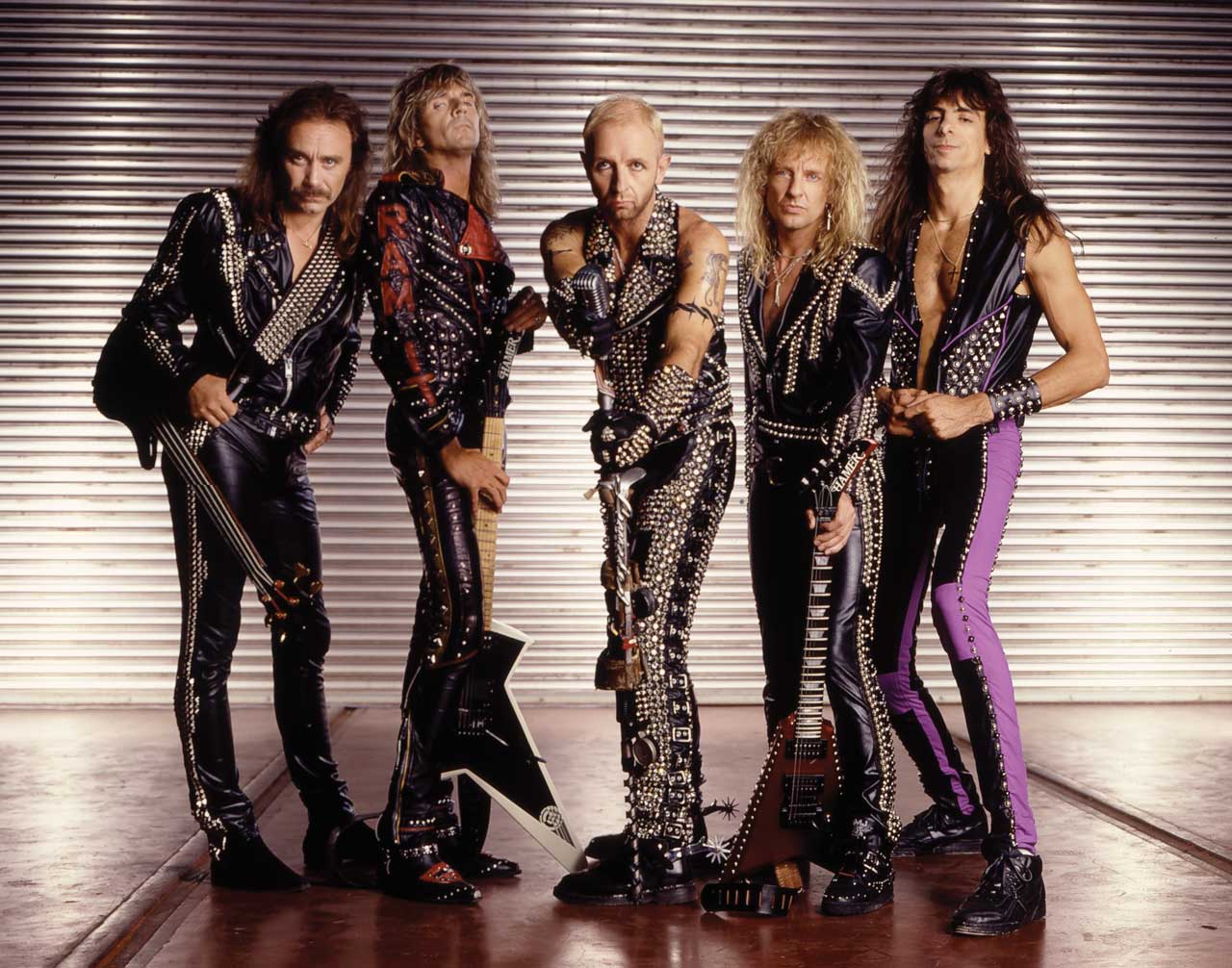1. Painkiller
James ‘Carrat’ Carrington, Mammoth Weed Wizard Bastard: “‘Faster than a laser bullet.’
"That lyric’s stuck with me since hearing Painkiller back in the day. Prior to this, I’d known Priest for robbing banks with guitars [in Breaking The Law’s video], but they’d turned into something genuinely scary to witness in the black-and-white video for this track.
"From the drilling kick-drums on the opening, through the Halford power-screamed lyrics pertaining to the titular cyborg saving mankind from destruction, to the two face-melting solos from Tipton and Downing. My god, those solos are fantastic. On a sidenote, check out Death’s cover of this track. It’s probably as good as the original.”
We say: Resoundingly blown open by a showcase drum barrage from new boy Scott Travis, Painkiller’s six hair-raising minutes returned Priest to the cutting edge of heavy metal as a new decade dawned.
The subsequent volley of strafing Glenn/K.K. riffs is soon followed by the shrieking intensity of Rob’s opening salvo: ‘Faster than a bullet, terrifying scream / Enraged and full of anger, he’s half-man and half-machiiine!’
Our shit was lost at this point, the opening title track from 1990’s molten metal masterpiece instantly grabbing a generation of headbangers who’d drifted away from Priest after 1986’s Turbo controversy and the coming of thrash.
The Brummies were themselves keen admirers of the aggressive new breed, taking Slayer out on 1988’s Mercenaries Of Metal Tour, and Painkiller sounds forged in the spirit of showing the new kids who’s boss.
“Our ambition is to fly the flag for metal and we feel that thrash and heavy metal is one and the same,” Glenn Tipton told Hammer in December 1990, adding: “We’re into thrash… We’re very aware of all the young bands and guitar players.”
“We always try to do something different, not to rest on our laurels,” affirms Ian Hill in 2019, when asked if Painkiller felt like a radical rebirth song.
“We’d done the experimental Turbo album, which had mixed reviews… that was a one-way street really, we weren’t going anywhere with heavy guitar synthesisers. [1988 LP] Ram It Down was where we got back the harder edge, so Painkiller was a follow-up to that, but more refined, very aggressive, very strong music.”
It was a baptism of fire for 28-year-old ex-Racer X drummer Scott Travis, who joined the band just a few months prior to recording Painkiller and ended up centre-stage on the album’s curtain-raiser, unprecedentedly unaccompanied for the first 15 seconds.
“Scott brought a hell of a lot,” enthuses Ian. “Dave Holland was a good drummer but he couldn’t handle double bass drums like that. If we’d still had Dave in the band, he wouldn’t have been able to do anything like it, so Scott’s input was tremendous. He enabled us to do that song at all.”
Another factor in Painkiller’s impact is the sheer power of the production, gifted by knob-twiddler extraordinaire Chris Tsangarides. Chris had been tape op/teaboy on 1976’s Sad Wings Of Destiny, going on to helm records for Thin Lizzy, Black Sabbath, Bruce Dickinson, Anvil, King Diamond and many more.
Tom Allom had handled Priest studio duties since 1980’s British Steel, helping cement the band’s success that decade, but now a new approach was needed: “Times change, and you’ve got to change with them,” Glenn pondered to Metal Hammer. “It’s 1990 now and we’ve updated our music.”

The change was instantly felt in Painkiller’s brash and radical ambience. “Chris came with great accolades,” recalls Ian of the much-missed maestro, who passed away last year.
“He was then an upcoming producer who’d been working with some of the newer bands of the time; his knowledge of metal was immense, so we gave him a go. He had good ideas about how to get various sounds, and worked out really well.”
Nearly 30 years on, Painkiller remains an electrifying experience, crammed with white-knuckle twists and turns, vigorous shifting tempos and haywire energy; everyone will have their favourite bit, but there’s something so scintillating about the way the action pauses to cue the sweep-picked arpeggio into Glenn’s magnificent solo – reputedly the guitarist’s personal favourite.
With all its chopping and changing, building and racing, sparks flying off drumsticks and fretboards, you might wonder if Painkiller took longer to nail than other Priest songs, but as ever, Ian took it in his stride.
“We spent about two weeks in Spain in this old finca we’d rented, where we could play it live and polish it up,” recalls the bassist, “so the recording was comparatively easy, as we all had a good idea of what we were doing.”
The song’s video – their fourth cut directed by Wayne Isham, fresh from working with Pink Floyd, the Stones, Ozzy, Bon Jovi and Def Leppard – was filmed in austere monochrome, in what looked like an iron foundry.
The strobing, rapid cutting and washes of bright light emphasise the song’s insistent harshness, perhaps wisely opting not to play out the lyrical narrative of the cybernetic superhero resurrecting mankind after Armageddon, which sounds very expensive.
In Hammer’s 2003 Xmas issue, Rob summed up Painkiller: “An archetypal metal moment,” he declared, “about a fantastic creature that personifies metal. The evil, the energy and the destruction.”
